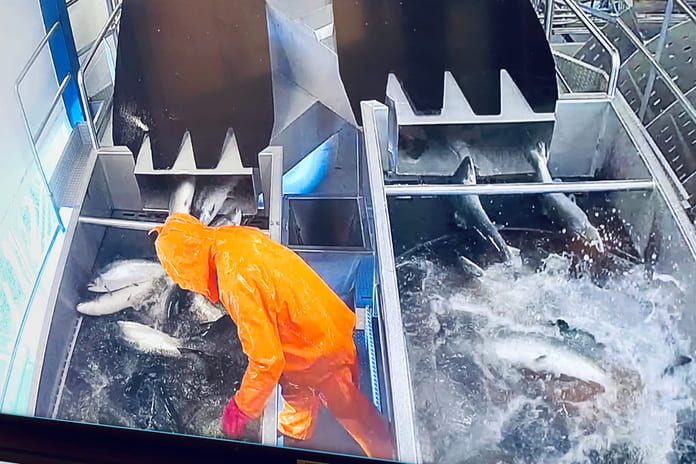“Demand for fillets goes crazy.”
The new fillet line set to work for the first time in May last year. With Mowi focussing on its own brand ‘Mowi Pure’ from Herøy, in Northern Norway, the filleting knives that had been tucked safely away in the drawer since 2011 have begun to be sharpened again on the island.
In the USA, Mowi hired 19 YouTube influencers to promote the brand. These influencers gave quick tips, recipes and other ideas for using the salmon.

“After we started the fillet department, it has just gone crazy,” said factory manager Gunnar Hamarsland. Together with production manager Tom Leirvik, he gives us a tour of the facility. Corona restrictions in place mean we are forced to observe the hectic activity around us through large glass shields.
70,000 salmon pumped in
On the day we visit, 20 tonnes will be processed for fillets, with 99 per cent superior D-trim. To achieve this, some 70,000 salmon are brought in from the holding pens. With a gutted weight of around six kilos each, this equates to a total of around 395 tonnes of the fish. A couple of days earlier, they managed 402 tonnes. For the past week, it’s been mainly large salmon rolling into the grade on Herøy. Right now, there are around 600 tonnes just in the holding pens.

With around 350 to 400 tonnes a day entering the factory, these cages must be constantly restocked. In the holding pens, a separate intake has been created just for pre-bled salmon. This is often used. A few days ago, the boat ‘Taupo” delivered more than 100 tons from nearby Åsvær.
“We have reasonably large volumes, a steady operation, high technical standards and fantastic people,” said Gunnar Hamarsland.
In the cold store, boxes are stacked with both whole fish and fillets, ready for market. Fifteen spaces are marked for pallets to fill a truck.
“The hall can take up to 20 trucks at a time. It is possible with a fifth loading ramp, but we now use only four. One truck is loaded in 35 minutes, so a load can leave every 45 minutes,” Hamarsland explains.
Mowi’s first feeding center
SalmonBusiness pays a quick visit to those who work on the sea side at Mowi on Ytre Helgeland. Here we meet the manager of the feeding centre, Roar Isaksen. From this room, he manages the seven localities in the area. When it opened in May 2019, it was the first such exchange in the Mowi system.

“More than four million salmon were released this spring. If we include the locality Breivika, west of the island of Løkta, we come close to 30,000 tonnes which we will deliver to the factory next year,” said Roar Isaksen.
Since March this year, Mowi Herøy has been testing the Sub-Chilling system from Skaginn3X. They describe the result so far, after just over three months of use, as simply ‘fantastic’.
In 2020, more than 70,000 tonnes of gutted salmon were despatched from the factory. The double shift system did not start until May. And with double shifts now running throughout this year, significantly larger production is expected. In addition to its own salmon, Herøy also processes fish for Lovundlaks, which has a permanent agreement to use the plant and well boat services from Mowi. LetSea will process salmon here this week, as well as Kvarøy Fiskeoppdrett.
Two salmon per second
Here inside the operations centre, it is essential to pay close attention to the screens. As two salmon per second roll through, there must be full control of the salmon’s path throughout the entire production process in the factory.
That job belongs to shift manager Matulevicius Giedrius who has been with Mowi since 2010, when he started as a summer worker in production. He is a trained transport engineer, but also has a background in logistics. He has control of two fish per second.

“The most important thing is to get good flow and optimal production. From the waiting cage until it is in boxes in the cold storage. Then it is they in logistics and transport who take over, and ensure the further flow,” said Giedrius.
“Here, the collaboration with the technical department must work well. Should there be a mistake with just one sensor, there will be trouble in the flow for Giedrius,” said factory manager Hamarsland.
“This is a fantastic place to run such production. With the local community here, and the knowledge and culture bearers, who have been with us from the beginning,” said a very satisfied Bergen resident on Herøy to SalmonBusiness.



